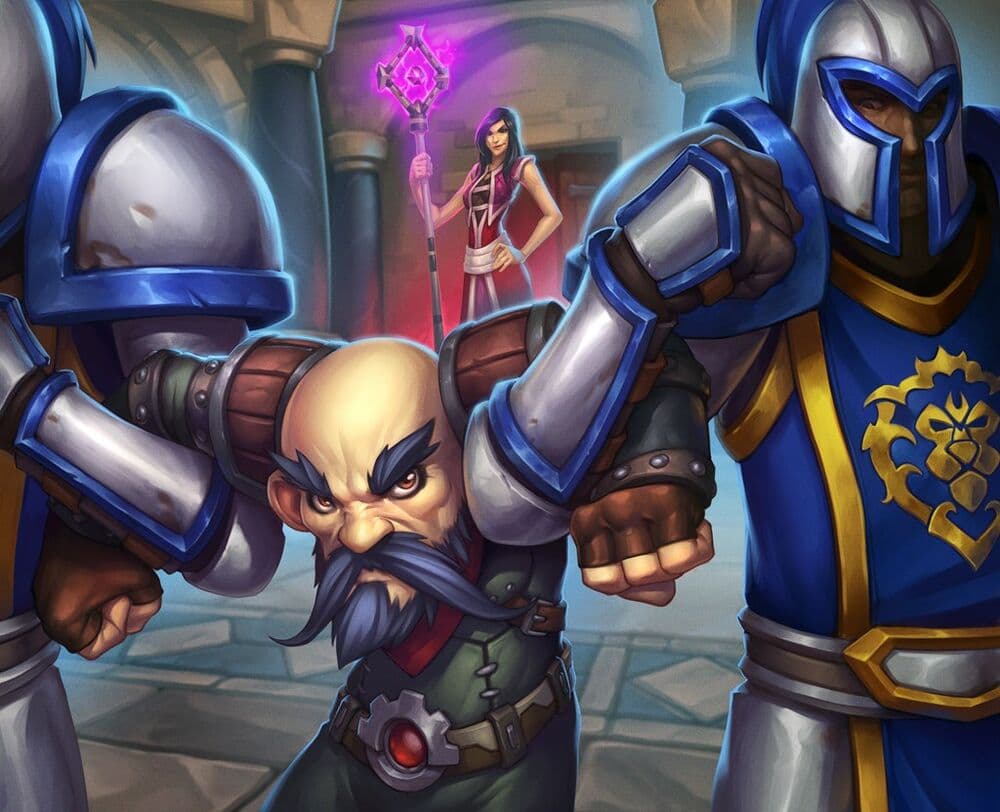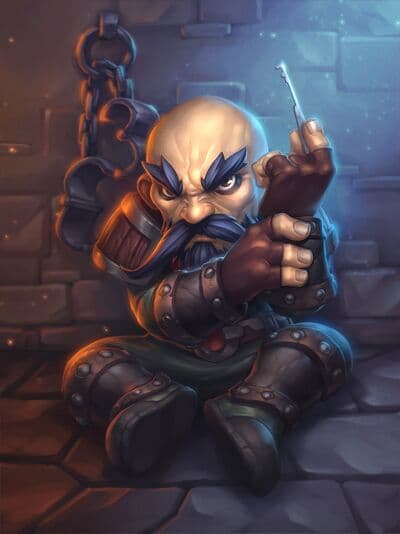We’re going to yoink this guide right off the table and start with a clean, powerful Quest list: Find the Imposter Rogue.

The rest of the West is almost too Wild right now, so let's first settle down with what we know. We’re going to yoink a guide right off the table and start with a clean, powerful Quest list: Find the Imposter Rogue. One might even say this deck has already started, explored, and completed its entire evolutionary trajectory. The Quest Rogue Guide seems to have been solved quickly-- but this provides to us a unique benchmark as one of the first few steps into this new jungle.
"Play two SI:7 cards, get a Gizmo-- play two SI:7 cards, get a Gizmo-- play two SI:7 cards, win the game."
United in Stormwind hand-wrapped an entire archetype for us Dagger-Up gamers. In a borderline unprecedented move a Quest was printed that checks not for game text, but name text. SI:7, the codename for Stormwind Intelligence, was a secret military branch of the Alliance royalty, and they have been thrust into the spotlight as the gates of Stormwind opened wide. Find the Imposter requires the player to work through a number of black-cloaked agents overflowing with Gizmos to ultimately summon the Rogue Quest God: Spymaster Scabbs.
One of the more slept-on Quests, no one was quite sure how well this would perform going into such a bizarre new landscape. In fact, no one even really started to play every SI:7 card until later into the week. But, more on that soon.
Quest Rogue Guide
Deck Code: AAECAaIHBMPhA5fnA53wA6b5Aw2qywPf3QPn3QOq6wOf9AOh9AOi9AOj9QOm9QPH+QP1nwT2nwSloAQA

To this day my games with this Quest still feel bizarre. There’s a mysterious quality to them, especially compared to what Miracle Rogue and Pre-Barrens Rogue could do with their explosives. There are no gigantic Thaurissan-style reductions anymore, no “Twenty Spells In One Turn Go”-- just curve out, beat down, and Squeeze.
There has been no better word for the majority of Rogue’s gameplay over the last year than the idea behind squeeze. I love the flexibility of the term, and it has come to suit a number of very different Rogue archetypes. Last format, for example, Forged in the Barrens had us trying to not overextend too far; to squeeze just hard enough while not overplaying your hand into the wealth of removal there was. Nowadays “to squeeze” is very much so the attempt to put out the light before it goes nuclear.
That’s what this deck wants to do: squeeze, while being one of the very same Quest decks that we hope to be squeezing. Every other Quest at the moment is focused on Combo, combo, cOmBo--! Rogue simply attempts to be the Quest Deck that gets “under” the others while still striving towards something powerful. The others are going to go Over us, blow the roof off the place. Find the Imposter has just enough gas to consistently and suddenly knock 'em out cold instead.
The deck is composed of a ton of "vanilla" minions: two mana 2/2s, three mana 3/3s, four mana 4/4s, all with barely any text at all. You'll find the likes of ancient, gray-haired SI:7 Agents and some minions you forgot existed like SI:7 Infiltrator. But yet they're just efficient enough and there's just enough Shadowstep nonsense to string together one Gizmo after another and end games.
Related articles
Why These Cards for Quest Rogue?

There was a fun little ecosystem that bubbled up while the world tested this deck. As one might expect, the deck started to "build itself"-- the Quest requires a number of SI:7 cards to actually do anything. A lot of the cards in your deck were "forced" to be played, limiting the range of what else you could play alongside them. But in the very beginning (we're talking the first few days of the new meta) there were still so many questions:
- "Do we have to play every SI:7 card?" Yes!
- "Do we play the Miracle package, the Stealth package, Secrets?" Miracle was everyone's first starting place, as it was the dominant Rogue archetype before Stormwind. Miracle was great at dismantling minion-centric boards-- but now Mage Quests and Warlock Quests and Demon Hunter Quest OTKs were flourishing.
- "Okay, which version do we play?" There were attempts to mimic things like the Tempo Rogue list that became known as Token Rogue, and a lot of cards carried over from Miracle like Secret Passage, Foxy Fraud, Swindle, and Wicked Stab*. But it was still taking a couple days as grinders fell in and out of sleep.
- "Wait, we should probably at least try every new SI:7 card, right?" The fans of "All-2-Of's" lists started backing up and rewinding-- "Let's just start with jamming every single SI:7 card, even these really goofy-looking four mana 3/3 Informants." And they were right-- Informant, a Rogue Chillwind Yeti-meets-Mountain Giant, was Fine Enough. It was okay to play a Yeti that helped fuel your Quest because your Quest was what mattered. Super Scabbs would end the game regardless of where you were-- just get there.
- "Wait, we should probably try every SI:7 card period, huh..." There was perhaps an even sillier SI:7 minion to include. Infiltrator, the one that eats Secrets and has literally never seen the light of day, found a way in. Maxing out on SI:7 cards became the best way to play, and especially because of one new card:
- "Battlegrounds Battlemaster isn't okay, is it?" This new Loatheb, a five mana Game Ender, was the talk of the Stormwind Trading District. This card completely snuck by under people's radar until Hunterace unveiled its hidden truth. In a world where Combo decks kill you on turn 7, the disruptive decks needed to do the same. Playing chunky four mana 6/6s in Rogue becomes a lot more enticing when that 6 becomes a 12. Spymaster Scabbs now represents 18 damage after being Stealthed by his own Gizmo! And with that, the final piece of the puzzle fell.
Play Patterns and Mulligans

If you were familiar with Rogue from right before the Quest, you likely had experience playing the brain-meltingly complicated board states of Miracle Rogue. This Quest Rogue guide is very different. Mulligans are straightforward in a new way, you halve your Cards Per Turn count, and you don't have to worry about Octo-bot math. It feels like a completely new beast!
Quest Rogue plays weirdly similar to Forged in the Barrens Rush Warrior--
- Control the board early with cheap but sticky minions
- Play one decent card a turn for the midgame
- Employ various little two-card-combos between turns 5 and 7
- Turn 8 revolves around game-breaking Spymaster Scabbs / Battlemaster turns a-la Troublemaker
Your Mulligans are very linear:
- Always keep your Quest
- Snap-keep SI:7 Skulker in every matchup
- The priority of "SI:7 Keeps" then becomes: Operative > Agent > Infiltrator > Informant
- I still aggressively mulligan the 4-mana cards for better 2s and 3s
- Extortion is a keep into Paladin, Hunter, and the Mirror
- On the Coin Scabbs Cutterbutter becomes a vile card, and you can keep a wider range of "Coin 3 into 3" plays
- Never Keep: Shadowstep, Secret Passage, Wicked Stab, Battlemaster
This deck is fun, straightforward, and good. But be careful-- nerfs are coming! Just not for us Rogues. As early as Blizzard Tuesday we might see changes that will instead upheave our Jenga tower meta of Combo. My prediction for Mage to go un-nerfed could be proven wrong right away, too. But as always, there's only one way to get there-- win until we find out!
Good luck gamers.